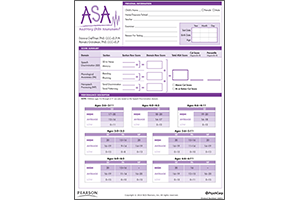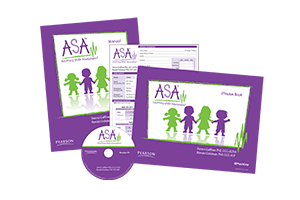ASA™ is a tool for early identification of young children who might be at risk for auditory skill deficits and/or early literacy skill difficulties. This screener provides accurate, developmentally based results to help determine which children may need follow-up, intervention, or further evaluation.





Auditory Skills Assessment
ASA
ASA™ is a tool for early identification of young children who might be at risk for auditory skill deficits and/or early literacy skill difficulties. This screener provides accurate, developmentally based results to help determine which children may need follow-up, intervention, or further evaluation.Choose from our formats
Kits
Starter & complete kits, print & digital
1 option
Test forms & reports
Booklets, record forms, answer sheets, report usages & subscriptions
1 option
Support materials
Manuals, stimulus books, replacement items & other materials
1 option
All products
All tests & materials offered for ASA
3 options